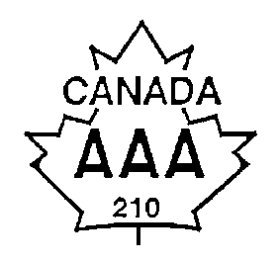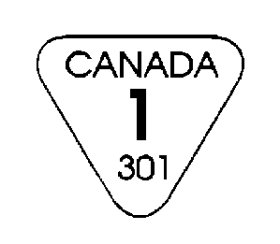Canadian Grade Compendium: Volume 1 – Ovine Carcasses and Poultry Carcasses
Part 2 Ovine Carcass Grade Requirements
Grades and Grade Names
3. There are five grades of ovine carcasses with the grade names Canada AAA, Canada C1, Canada C2, Canada D1 and Canada D4 (see Volume 9, Import Grade Requirements for grade names used for imported ovine carcasses).
General
4. (1) A grader, when requested by the licence holder, or the licence holder under the direct supervision of a grader, must mark the ovine carcass with a grade stamp, illustrated in Schedule 3 – Ovine Carcass Grade Stamp to this Part, in red ink, on the leg and foresaddle, on both sides of the lamb carcass.
(2) If requested by the licence holder, a lamb carcass that meets the requirements for grade Canada AAA must be marked with a yield stamp Canada 1, Canada 2, Canada 3 or Canada 4, in accordance with the yield class determined in subsection (6),
(3) The yield stamp, referred to in subsection (2), illustrated in Schedule 4 – Lamb Carcass Yield Stamp to this Part as a triangle, must be applied by a grader, or by the licence holder under the direct supervision of a grader, in red ink, on the leg and foresaddle, on both sides of the lamb carcass.
(4) A inspector, or an employee of a licence holder, must determine the maturity of an ovine carcass
- (a) by examining its dentition; or
- (b) by determining the presence of a break joint or spool joint and examining the colour and distribution of blood deposits in the joint.
(5) A grader must determine the fat level of an ovine carcass by measuring the fat with a ruler over the twelfth rib and 11 cm off the midline of the ovine carcass.
(6) The yield class of a lamb carcass, determined by a grader, that is graded Canada AAA and that has a fat measurement set out in Column 1 of an item of the Table for Yield Class for Lamb Carcasses Graded Canada AAA is the yield class set out in Column 2 of that item.
| Item | Column 1 Fat Measurement (mm) |
Column 2 Yield Class |
|---|---|---|
| 1. | Less than 13 | Canada 1 |
| 2. | 13 to 18.9 | Canada 2 |
| 3. | 19 to 24.9 | Canada 3 |
| 4. | 25 or more | Canada 4 |
(7) A grader must determine the average musculature score of every lamb carcass by evaluating the musculature of each primal cut, by assigning a score ranging from a minimum of 1 to a maximum of 5 for the musculature of each primal cut, by determining the total musculature score for the primal cuts and by dividing the total musculature score by 3.
Grade Requirements for Canada AAA
5. An ovine carcass graded Canada AAA must have
- (a) the maturity characteristics set out in Schedule 1 – Maturity Characteristics for Lamb Carcasses to this Part;
- (b) a minimum musculature score of 2 for each primal cut and a minimum average musculature score of 2.6;
- (c) flank muscles that are pink to light red in colour;
- (d) a fat covering that
- (i) is firm and white or slightly tinged with a reddish or amber colour,
- (ii) is not less than 4 mm in thickness at the measurement site, and
- (iii) extends to provide at least a thin cover over the top of the shoulders, the back and the outside of the centre part of the legs; and
- (e) a minimum of traces of fat streakings on the inside flank muscles.
Grade Requirements for Canada C1
6. An ovine carcass graded Canada C1 must have
- (a) the maturity characteristics set out in Schedule 1 – Maturity Characteristics for Lamb Carcasses to this Part;
- (b) a minimum musculature score of 1 for each primal cut or a minimum average musculature score of less than 2.6;
- (c) flank muscles that are pink to light red in colour; and
- (d) a fat covering that
- (i) is firm and white or slightly tinged with a reddish or amber colour, and
- (ii) is less than 4 mm in thickness at the measurement site.
Grade Requirements for Canada C2
7. An ovine carcass graded Canada C2 must have the maturity characteristics set out in Schedule 1 – Maturity Characteristics for Lamb Carcasses to this Part and
- (a) flank muscles that are dark red in colour; or
- (b) a fat covering that is yellow in colour.
Grade Requirements for Canada D1
8. An ovine carcass graded Canada D1 must have
- (a) the maturity characteristics set out in Schedule 2 – Maturity Characteristics for Mutton Carcasses to this Part; and
- (b) a fat covering that is less than 13 mm in thickness at the measurement site.
Grade Requirements for Canada D4
9. An ovine carcass graded Canada D4 must have
- (a) the maturity characteristics set out in Schedule 2 – Maturity Characteristics for Mutton Carcasses to this Part; and
- (b) a fat covering that is 13 mm or more in thickness at the measurement site.
Schedule 1 – Maturity Characteristics for Lamb Carcasses
- Fewer than two permanent incisors;
or
- Two break joints or, in the case of a carcass with one break joint and one spool joint, the break joint has four intact and well-defined ridges with at least a slightly red and slightly damp surface.
- Ribs that are no more than slightly wide, tend to be rounded rather than flat and are reddish in colour.
An ovine carcass could contain two permanent incisors and still be considered a lamb, if items 2 and 3 above are met.
Schedule 2 – Maturity Characteristics for Mutton Carcasses
- Two or more permanent incisors.
- Two spool joints or, in the case of a carcass with one break joint and one spool joint, the break joint has a dry and mainly white surface.
- Ribs that are wide, flat and white.
Schedule 3 – Ovine Carcass Grade Stamp

Schedule 4 – Lamb Carcass Yield Stamp

- Date modified: